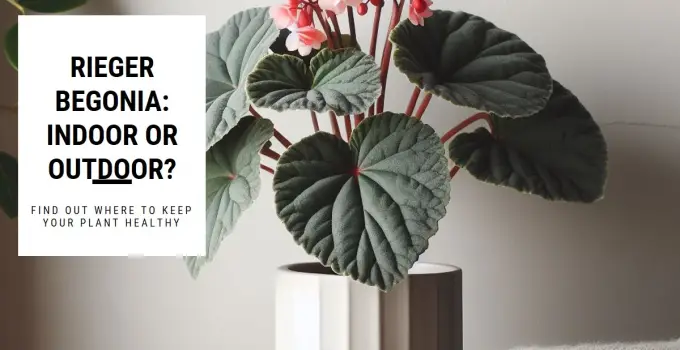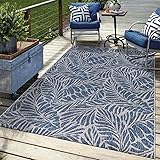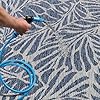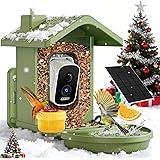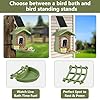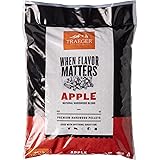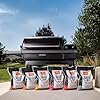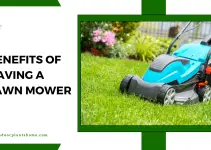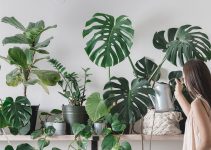Sewing Machine Christmas Ornament Acrylic Suncatcher with Floral Design Stained Glass Effect Window Hanging Gifts for Sewer and Quilter Craft Room Garden Decor Crafter Birthday Present
$14.95 (as of December 24, 2025 03:35 GMT +00:00 - More infoProduct prices and availability are accurate as of the date/time indicated and are subject to change. Any price and availability information displayed on [relevant Amazon Site(s), as applicable] at the time of purchase will apply to the purchase of this product.)Keen Home Design Terrace Outdoor Area Rug - 8x10 Washable Indoor/Outdoor Rug for Patio, Kitchen, Balcony, Beach, Garden, Deck and Porch, Size: 7'7"x10'
$149.99 (as of December 24, 2025 01:03 GMT +00:00 - More infoProduct prices and availability are accurate as of the date/time indicated and are subject to change. Any price and availability information displayed on [relevant Amazon Site(s), as applicable] at the time of purchase will apply to the purchase of this product.)Is Rieger Begonia an Indoor or Outdoor Plant?
Rieger begonias are versatile plants that can be grown successfully both indoors and outdoors. With their colorful blooms and low maintenance needs, they make an excellent addition to containers and garden beds.
Begonias are popular flowering plants appreciated for their showy blossoms and attractive foliage. There are over 1,800 species and countless hybrids within the Begonia genus. One of the most widely available varieties is the Rieger begonia. But is it better suited to growing indoors or outdoors?
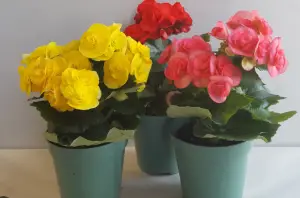
The good news is that Rieger begonias are adaptable to both indoor and outdoor environments. With proper care, they can thrive in planters and flower beds alike. Read on to learn more about Rieger begonia characteristics and how to decide where is best to grow them.
Overview of Rieger Begonias
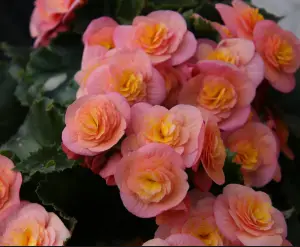
Here’s a quick overview before diving into where best to grow Rieger begonias:
- Type: A hybrid flowering begonia.
- Origins: Cross between tuberous and wax begonias.
- Flowers: Showy, rose-like blooms in shades of pink, red, white, orange, yellow.
- Foliage: Rounded, succulent green or bronze leaves.
- Height: Typically 6 to 12 inches tall.
- Hardiness Zone: Grown as annuals; hardy in zones 9-11 as perennials.
- Light Needs: Thrive in partial shade or filtered sunlight.
- Soil: Well-draining, humus-rich potting mix.
- Water: Consistent moisture, allow soil to dry between waterings.
- Uses: Beds, borders, hanging baskets, window boxes, container gardens.
With proper care, Rieger begonias can flexibly grow in indoor or outdoor settings. Next let’s compare how they perform in each environment.
Growing Rieger Begonias Indoors
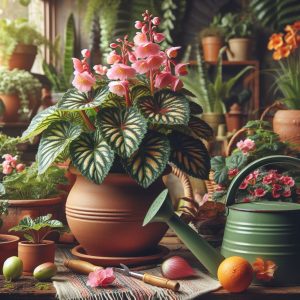
Rieger begonias are well-suited to growing as houseplants or seasonal indoor bloomers. Here are the pros and cons of growing them indoors:
Advantages of Indoor Growth
- Protects from cold temperatures
- Continues blooming regardless of season
- Convenient to display in home or office
- Easy to control lighting, temperature, humidity
- Avoid potential pest and disease issues
Disadvantages of Indoors
- Requires providing adequate sunlight by windows or grow lights
- Lack of air circulation can lead to mildew
- Requires more attentive soil moisture monitoring
- Limited by container size unless planted in ground indoors
Tips for Growing Indoors
- Place in bright, south or west facing window for ample filtered light.
- Water when top 1″ of soil dries; avoid wet feet.
- Average indoor temperatures of 65-75°F are ideal.
- Provide good air flow with fans to prevent mildew on leaves.
- Fertilize monthly with balanced liquid fertilizer during growth.
- Prune back spent blooms to encourage new flowering.
With the right care, Rieger begonias will thrive indoors and provide cheerful blooms year-round.
Cultivating Rieger Begonias Outdoors
Rieger begonias also take well to outdoor cultivation in garden beds and containers. Here are the pros and cons of growing them outdoors:
Advantages of Outdoor Growth
- Exposure to natural sunlight fuels prolific flowering.
- Can plant directly in garden beds for fuller growth.
- Natural rainfall provides ample hydration.
- Excellent for porches, patios and outdoor living spaces.
- Typically fewer disease issues with increased air circulation.
Disadvantages of Outdoors
- Must protect from frost and cold temperatures.
- Heavy rainfall can lead to root rot if drainage is poor.
- May require covering or moving indoors if weather turns.
- Deer, slugs and snails may feed on foliage and flowers.
Tips for Growing Outdoors
- Select partially shaded, protected garden sites or containers.
- Use peat moss in soil to help retain moisture between rainfalls.
- Bring indoors or cover if temperatures drop below 60°F.
- Stake tall varieties if needed to prevent toppling in rain and wind.
- Pick off any damaged foliage which can allow disease entry.
With adequate care, Rieger begonias will flourish outdoors and give super-sized floral displays.
Directly Comparing Indoor vs. Outdoor Growth
To decide whether to grow Rieger begonias indoors vs. outdoors, compare the key factors:
| Comparison | Indoors | Outdoors |
|---|---|---|
| Light | May need grow lights. | Natural light fuels flowering. |
| Size | Limited by container. | Can plant in ground for larger growth. |
| Flowering | Year-round blooms. | Max bloom during summer. |
| Temperature | Easier to control stable optimal temps. | Hardiness only to zone 9; needs winter protection. |
| Humidity | Can be too dry without humidifying. | Natural rainfall provides humidity. |
| Pests | Usually fewer problems indoors. | Deer, slugs, snails may attack plants. |
| Diseases | Good air flow needed to prevent mildew. | Improved airflow reduces disease issues. |
In summary, indoor growth allows more control over care but smaller plants, while outdoor growth fuels bigger, more prolific flowering begonias that need protection from pests and cold.
Either way, with proper care Rieger begonias can thrive indoors or out depending on your specific needs and growing conditions.
Tips for Successful Indoor or Outdoor Growth
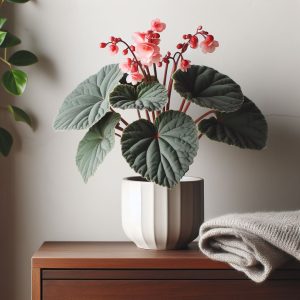
Here are some key tips to grow beautiful, flowering Rieger begonias in any environment:
- Soil – Use a rich, well-draining potting mix. Regularly fertilize during growing season.
- Water – Keep soil consistently moist but not saturated. Allow potting mix to dry out between waterings.
- Light – Rieger begonias need 4-6 hours of very bright, filtered sunlight daily. Provide grow lights if needed.
- Temperature – Prefer average temps of 65-75°F during the day and above 55°F at night. Bring indoors or protect from frost.
- Pruning – Deadhead spent blooms to encourage more flowering. Cut back significantly in fall before reducing water for dormancy.
- Propagation – Easily propagated from stem cuttings in spring or summer.
Follow these guidelines tailored to your unique growing conditions, and Rieger begonias will generously reward you with abundant blossoms and attractive foliage whether enjoyed indoors or out.
Common Questions About Rieger Begonias
Here are answers to some frequently asked questions to help ensure your Rieger begonias thrive beautifully:
How long do Rieger begonias bloom?
With proper care, Rieger begonias typically bloom continuously from late spring through the end of summer outdoors. Indoors they may bloom year-round except for a brief resting period.
What are the most common pests and diseases?
Aphids, slugs and snails are common pests. Powdery mildew is the most prevalent disease, especially in poor air circulation indoors. Good cultural practices help prevent problems.
Should I cut back Rieger begonias in winter?
Yes, significantly cut back the entire plant before bringing it indoors or reducing water for winter dormancy. This promotes a compact shape and prolific reblooming next season.
How often do Rieger begonias need to be fertilized?
While actively growing and flowering, fertilize Rieger begonias every 2-4 weeks using a balanced liquid fertilizer diluted to half strength. Discontinue fertilizer after blooming slows in fall.
What are the best uses in the landscape?
Rieger begonias shine in containers, window boxes, hanging baskets and garden borders. Their mounded form and profuse flowers are ideal for decorative planters and flower beds.
Achieve Abundant Blooms Indoors or Out
Rieger begonia’s versatility allows you to enjoy its colorful, abundant blossoms whether grown as a houseplant or ornamenting your outdoor living space. With proper selection of lighting, careful hydration and protection from temperature extremes, Rieger begonias are sure to flourish.
If enjoying these heat-loving begonias as annuals in colder climates, take cuttings at the end of the season to carry stock plants indoors over winter. Then propagate new plants for your indoor and outdoor displays next spring.
With a basic understanding of Rieger begonia’s preferences and ideal growing guidelines, you’ll be rewarded with vivid bouquets of flowers that brighten their surroundings inside

